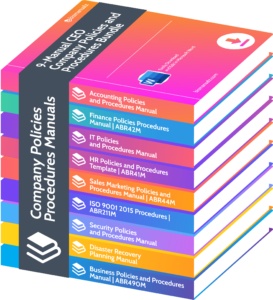What Should a CEO Know About Workflow Automation Tools?

Are you a CEO struggling to streamline your company’s workflow? The importance of efficient workflow cannot be overstated – it directly impacts productivity, profitability, and customer satisfaction. In this article, we will explore the world of workflow automation tools and how they can benefit you as a CEO. Stay ahead of the game with these essential tools. What should a CEO know about workflow automation tools?
What Is Workflow Automation?

CEO Policies and Procedure
Workflow automation is the utilization of technology to simplify and automate recurring tasks and processes within a company. This includes the implementation of software tools and systems to automate tasks like data entry, document routing, and approval processes.
By automating workflows, efficiency and productivity can be improved by minimizing manual errors and expediting the completion of tasks. Additionally, workflow automation enables better monitoring and tracking of processes, ensuring that they are completed within the designated timeframe. Ultimately, workflow automation is a valuable tool for organizations as it saves time, reduces costs, and enhances overall operational effectiveness.
Why Is Workflow Automation Important for a CEO?
Workflow automation plays a crucial role for CEOs as it simplifies business processes, increases productivity, and enhances decision-making. By utilizing automation tools, CEOs can eliminate manual tasks, reduce errors, and improve overall efficiency. This allows CEOs to focus on strategic initiatives and driving business growth.
Furthermore, workflow automation provides real-time insights and analytics, empowering CEOs to make data-driven decisions. It also encourages collaboration among teams, ensuring seamless communication and coordination.
To effectively leverage workflow automation, CEOs should invest in user-friendly tools, provide proper training to employees, and regularly review and update workflows to adapt to evolving business needs.
What Are The Benefits of Workflow Automation?
In today’s fast-paced business world, workflow automation has become an essential tool for companies looking to streamline their processes and improve overall efficiency. In this section, we will discuss the various benefits of implementing workflow automation, including increased efficiency, improved communication and collaboration, reduction of errors and delays, and better resource allocation. By understanding these advantages, CEOs can make informed decisions about implementing workflow automation in their organizations.
1. Increased Efficiency
Increased efficiency is a major advantage of utilizing workflow automation tools for CEOs. By implementing workflow automation, businesses can streamline processes and eliminate manual tasks. Here are the steps to achieve increased efficiency:
- Analyze current processes and identify any bottlenecks or inefficiencies.
- Map out the ideal workflow and pinpoint areas that can be automated.
- Select a workflow automation tool that is suitable for your organization’s specific needs.
- Implement the chosen tool and configure workflows according to your requirements.
- Train employees on how to effectively use the automation tool.
- Monitor and evaluate the impact of automation on efficiency and productivity.
Fact: By reducing manual effort by up to 80%, workflow automation enables CEOs to focus on strategic decision-making and driving business growth.
2. Improved Communication and Collaboration
Improved communication and collaboration are key benefits of implementing workflow automation for CEOs. To enhance these aspects, here are a few steps to follow:
- Utilize real-time messaging platforms to facilitate instant communication among team members.
- Implement project management software to allocate tasks, set deadlines, and track progress collaboratively.
- Create centralized document management systems to allow easy access and editing of files by multiple stakeholders.
- Integrate video conferencing tools for virtual meetings and discussions, promoting face-to-face communication.
For example, a CEO of a global tech company successfully implemented workflow automation tools, resulting in seamless communication and collaboration among international teams. This led to faster project completion, efficient team collaboration, increased productivity, and improved outcomes.
3. Reduction of Errors and Delays
Reducing errors and delays through workflow automation is crucial for improving efficiency and productivity. Here are steps to achieve this:
- Identify bottlenecks: Analyze the workflow to identify areas where errors and delays commonly occur.
- Standardize processes: Implement standardized procedures to ensure consistency and minimize human errors.
- Automate repetitive tasks: Use workflow automation tools to automate routine tasks, reducing the chance of errors and speeding up processes.
- Implement notifications and alerts: Set up notifications and alerts to keep stakeholders informed of upcoming deadlines and potential issues.
- Track and analyze performance: Monitor and analyze workflow data to identify areas for improvement and address any recurring errors or delays.
By following these steps, CEOs can achieve a reduction of errors and delays, leading to enhanced operational efficiency.
4. Better Resource Allocation
Effective workflow automation can greatly improve resource allocation within an organization. Here are the steps to achieve better resource allocation:
- Analyze existing workflows and identify areas where resources are being underutilized or misallocated.
- Implement automation tools that can streamline processes and eliminate inefficiencies.
- Assign resources based on their skills and expertise, ensuring that each task is matched with the right person.
- Monitor resource allocation regularly and make adjustments as needed to optimize productivity and minimize waste.
By following these steps and leveraging workflow automation, CEOs can ensure that resources are allocated effectively, leading to improved efficiency and better utilization of available resources.
What Are The Types of Workflow Automation Tools?
As a CEO, it is crucial to stay informed about the latest tools and technologies that can streamline and improve your company’s workflows. One area of growing interest is workflow automation tools, which can help automate and optimize various business processes.
In this section, we will discuss the different types of workflow automation tools available and how they can benefit your organization. From business process management software to robotic process automation, document management, and project management software, we will cover the key features and functions of each type. So, let’s dive in and discover the various options for automating your workflows.
1. Business Process Management Software
Business Process Management (BPM) software is a powerful tool that helps streamline and optimize business processes, improving efficiency and productivity. Here are the key steps involved in effectively utilizing BPM software:
- Analyze current processes: Identify areas that can benefit from automation and optimization.
- Design workflows: Create visual representations of the desired optimized processes.
- Configure the software: Customize the BPM software to align with your specific business needs and requirements.
- Automate tasks: Use the software to automate repetitive and manual tasks, reducing errors and saving time.
- Monitor and analyze: Continuously monitor the performance of the automated processes and use analytics to identify bottlenecks and areas for improvement.
- Optimize and refine: Make necessary adjustments to the workflows based on the insights gained from monitoring and analysis.
- Collaborate and communicate: Utilize the software’s features to enable seamless collaboration and communication among team members involved in the processes.
By implementing Business Process Management (BPM) software, CEOs can achieve greater operational efficiency, improved decision-making, and enhanced overall business performance.
2. Robotic Process Automation Software
Robotic Process Automation (RPA) software is a valuable tool for CEOs looking to streamline business processes and improve efficiency. Here are some steps to consider when implementing RPA software:
- Evaluate your processes: Identify repetitive and rule-based tasks that can be automated using RPA.
- Choose the right tool: Select an RPA software that aligns with your business needs and offers features like a drag-and-drop interface and easy integration.
- Map out the process: Create a detailed workflow diagram to visualize the automated steps and identify potential bottlenecks.
- Configure and test: Configure the RPA software to replicate the manual steps and thoroughly test it to ensure accuracy and reliability.
- Monitor and optimize: Continuously monitor the automated process, gather data, and make improvements to optimize performance.
Implementing RPA software can boost productivity, reduce errors, and free up time for strategic decision-making. To make the most of RPA, ensure scalability, integration with existing systems, user-friendliness, and adherence to security and compliance standards.
3. Document Management Software
Document management software plays a crucial role in workflow automation, helping CEOs streamline their business processes and improve efficiency. Here are the steps to effectively utilize this technology:
- Identify your organization’s document storage needs and requirements.
- Choose a document management software that aligns with your specific needs, such as a cloud-based storage solution.
- Digitize and organize your existing documents for easy access and efficient retrieval.
- Create document templates to standardize and streamline processes, reducing errors and saving time.
- Implement version control features to track document revisions and ensure accuracy.
- Enable collaboration by allowing multiple users to access and work on documents simultaneously.
- Integrate the software with other tools and systems to enhance workflow automation.
- Train employees on how to effectively use the software and encourage adoption throughout the organization.
In the early 2000s, document management software revolutionized the way businesses handled paper-based documents. This innovative technology allowed organizations to transition to digital document storage, eliminating the need for physical file cabinets and improving accessibility and security.
Today, document management software continues to evolve, offering advanced features such as artificial intelligence for intelligent document recognition and automated workflows to enhance productivity.
4. Project Management Software
Project management software is an essential tool for CEOs, providing efficient project planning, task management, and collaboration features. It aids in monitoring project progress, deadlines, and resource allocation with ease.
CEOs can reap numerous benefits from project management software, such as improved team coordination, increased productivity, and informed decision-making based on real-time data. When selecting a project management software, CEOs should consider factors like scalability, customization options, integration with existing systems, user-friendliness, and security compliance.
By utilizing project management software effectively, CEOs can ensure smooth and efficient execution of projects, resulting in successful outcomes.
How Can Workflow Automation Help a CEO?
As a CEO, one of your top priorities is to ensure the smooth operation and success of your company. This is where workflow automation comes in. By utilizing automation tools, you can streamline your business processes, increase productivity and profitability, make data-driven decisions, and improve employee satisfaction and retention. In this section, we will delve into how workflow automation can specifically benefit a CEO and their organization.
1. Streamline Business Processes
Streamlining business processes is crucial for CEOs to increase efficiency and productivity. Here are the steps to achieve streamlined processes:
- Identify bottlenecks and areas for improvement.
- Map out current workflows and analyze them.
- Eliminate unnecessary steps and automate repetitive tasks.
- Implement a workflow automation tool to centralize and streamline processes.
- Integrate the tool with existing systems for seamless data flow.
- Customize the tool to fit specific business needs.
- Train employees on effectively using the tool.
- Monitor and analyze the results, making necessary adjustments.
Achieving streamlined processes can result in improved productivity, reduced errors, and better resource allocation, benefiting both the CEO and the entire organization.
Fun Fact: In the early 20th century, Henry Ford revolutionized the manufacturing industry by streamlining the production process for automobiles with the invention of the assembly line.
2. Increase Productivity and Profitability
Workflow automation can greatly enhance productivity and profitability for CEOs by streamlining processes and optimizing resource allocation. Here are the steps to leverage workflow automation for increased productivity and profitability:
- Identify repetitive tasks that can be automated, such as data entry or report generation.
- Choose a workflow automation tool that aligns with your business needs and seamlessly integrates with existing systems.
- Create automated workflows that eliminate manual handoffs and reduce the risk of errors and delays.
- Monitor and analyze workflow data to identify bottlenecks and areas for improvement.
- Continuously optimize workflows based on data insights and feedback.
By implementing workflow automation, CEOs can streamline operations, boost efficiency, and drive profitability by focusing on strategic initiatives and value-added tasks.
3. Make Data-Driven Decisions
Making data-driven decisions is an essential aspect of workflow automation for CEOs. Here are the steps to effectively utilize data in decision-making:
- Identify relevant data sources: Determine the key data points needed for making data-driven decisions.
- Collect and analyze data: Gather data from various sources and use analytics tools to analyze and interpret it.
- Extract actionable insights: Identify patterns, trends, and correlations within the data to derive actionable insights.
- Apply insights to decision-making: Utilize the insights gained from the data analysis to make informed and strategic decisions.
- Monitor and evaluate: Continuously monitor the outcomes of data-driven decisions and evaluate their effectiveness.
By following these steps, CEOs can harness the power of data to drive their decision-making processes and enhance overall business performance.
4. Improve Employee Satisfaction and Retention
Improving employee satisfaction and retention is crucial for the success of any organization. Here are some steps to achieve this:
- Create a positive work environment by fostering open communication and promoting a healthy work-life balance.
- Recognize and reward employees for their hard work and accomplishments to boost morale and motivation.
- Offer opportunities for professional growth and development, such as training programs and career advancement prospects.
- Implement a fair and competitive compensation and benefits package to attract and retain top talent and improve employee satisfaction and retention.
- Encourage teamwork and collaboration to foster a sense of belonging and camaraderie among employees.
Pro-tip: Regularly solicit feedback from employees and use it to make meaningful improvements in the workplace, showing that their opinions and voices are valued.
What Are The Considerations for Choosing a Workflow Automation Tool?
When it comes to implementing a workflow automation tool, there are several key factors that a CEO must consider. These considerations will not only impact the effectiveness and efficiency of the tool, but also the overall success of the organization.
In this section, we will discuss the important considerations for choosing a workflow automation tool, including scalability and customization, integration with existing systems, user-friendliness and training, and security and compliance. By understanding these crucial factors, CEOs can make informed decisions when selecting a workflow automation tool for their company.
1. Scalability and Customization
Scalability and customization are essential considerations for CEOs when selecting a workflow automation tool. Here are the steps to assess these aspects:
- Evaluate Business Growth: Determine if the tool can handle increasing workflow demands as your company expands.
- Flexibility: Look for a tool that allows for customization to tailor workflows to your specific business processes.
- Integration: Ensure the tool can integrate with existing systems and software to streamline operations.
- User Interface: Evaluate the tool’s user-friendliness to promote ease of use and adoption among employees.
Fact: Workflow automation tools that offer scalability and customization can help CEOs optimize operations and efficiently adapt to changing business needs.
2. Integration with Existing Systems
When selecting a workflow automation tool, it is important to consider the integration with your current systems. Here are the steps to ensure a seamless integration:
- Identify existing systems: Begin by identifying the software and applications currently being used in your organization.
- Evaluate compatibility: Evaluate if the workflow automation tool can easily integrate with your existing systems. Look for features such as APIs or connectors.
- Check data transfer: Make sure that data can be transferred between systems without any errors or loss.
- Consider customization: Ensure that the automation tool allows for customization to meet your specific integration requirements.
- Test integration: Perform thorough testing to ensure smooth communication and data flow between different systems.
Fact: According to a study by MuleSoft, 94% of organizations believe that integrating existing systems is crucial for a successful digital transformation.
3. User-Friendliness and Training
User-friendliness and training are crucial factors to consider when selecting a workflow automation tool. To ensure a smooth adoption process, follow these steps:
- Assess User-Friendliness: Evaluate the tool’s interface, ease of navigation, and intuitiveness to ensure it can be easily used by employees.
- Training Resources: Look for tools that offer comprehensive training materials such as tutorials, guides, and videos to support employees in learning the tool.
- Training Sessions: Arrange training sessions or workshops to familiarize employees with the tool’s features and functionalities.
- User Support: Make sure that the tool has a responsive and helpful customer support team that can assist with any technical issues or questions.
By prioritizing user-friendliness and providing sufficient training, CEOs can guarantee a successful implementation of workflow automation tools within their organization.
4. Security and Compliance
Ensuring security and compliance is of utmost importance when selecting a workflow automation tool for a CEO. To make the best choice, here are some steps to consider:
- Evaluate the tool’s data encryption capabilities to safeguard sensitive information.
- Check if the tool has built-in access controls, enabling you to assign user permissions and restrict unauthorized access.
- Consider if the tool offers compliance features, such as audit trails and regulatory compliance templates.
- Assess the tool’s ability to integrate with existing security protocols and compliance systems.
It is highly recommended to consult with IT and legal teams to ensure that the chosen tool meets all necessary security and compliance requirements.
Frequently Asked Questions

What should a CEO know about workflow automation tools?
Workflow automation tools are software programs that help streamline and automate repetitive tasks within a business process. As a CEO, it’s important to understand how these tools can benefit your company and how to effectively implement them. Here are some key things to know:
What are the benefits of using workflow automation tools?
There are several benefits of using workflow automation tools, including increased efficiency, improved accuracy, and cost savings. By automating repetitive tasks, your employees can focus on more important and high-value tasks, leading to increased productivity and a more streamlined workflow.
How can workflow automation tools improve company workflow?
Workflow automation tools can improve company workflow by automating manual processes, reducing errors, and providing real-time data and insights. This can result in a more efficient and streamlined workflow, leading to increased productivity and better decision-making.
What types of tasks can be automated with workflow automation tools?
Workflow automation tools can automate a variety of tasks, such as data entry, document routing and approval, email notifications, and task assignment. They can also integrate with other software systems, allowing for seamless communication and data transfer.
What factors should a CEO consider when choosing a workflow automation tool?
When choosing a workflow automation tool, a CEO should consider the specific needs and processes of their company, the level of customization and scalability offered by the tool, and the user-friendliness for employees. It’s also important to research the reputation and customer reviews of the tool and its provider.
How can a CEO successfully implement workflow automation tools in their company?
To successfully implement workflow automation tools, a CEO should involve key stakeholders and employees in the decision-making process, provide adequate training and resources, and continuously monitor and evaluate the effectiveness of the tool. It’s also important to have a clear plan and strategy for how the tool will be integrated into company processes.















Leave a Reply